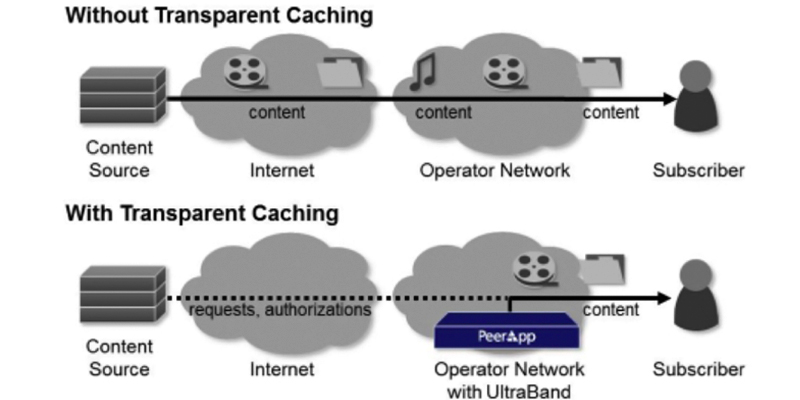BCS Stories
Interoperability of open cache to transform CDNs

Streaming content is increasingly delivered in 4K and soon 8K, supporting augmented reality and virtual reality (AR/VR) applications across multiple devices, over wireline and wireless connections. This drives network capacity demands, with consumer internet video traffic expected to comprise 82 percent of all (consumer) internet traffic by 2022, (up from 73% in 2017.)
Resulting performance requirements are accelerating the shift away from traditional content delivery models, opening up the opportunity for service providers to use their edge assets to deploy their own distributed CDN capabilities, and become more active participants in the streaming media delivery value chain.
Industry and streaming ecosystem support for open caching is growing, with over 50 global service providers, technology vendors, and content publishers actively involved in moving the content-delivery industry in this direction.
The Walt Disney Company and Verizon recently began trialing advanced content-caching technology in the FIOS network that will improve the experience for customers streaming Disney+ content over their Verizon FIOS service. Throughout the past few months, building on Verizon’s existing edge-caching capabilities, the companies have collaborated on a trial using Verizon’s new open caching (OC) platform. Based on open specifications, developed by the Streaming Video Alliance, Verizon’s OC platform stores the most-requested streaming video content, like Falcon and The Winter Soldier, in network facilities closer to the customer, which results in content starting faster, while also reducing freezing, pausing, or playback failures during streaming.
Caching popular internet content at the network edge closer to end-users is a standard ISP network management practice that has long been a part of the internet’s architecture. Verizon’s OC platform, based on specifications developed by the Streaming Video Alliance’s Open Caching Working Group, serves content from caching servers located at the edge of the network closer to the customer as opposed to servers in cloud data centers that could be further away from where customers are engaging with the content.
By storing content closer to customers, the data travels a shorter distance over the network, through fewer routers and switches, reducing delays in delivery of content to the customer. As a result, customers are able to start streaming content more quickly and face fewer potential network events that could cause freezing or buffering. In this trial, FIOS customers throughout the Verizon FIOS footprint were able to access Disney content using open caching. Results from the trial showed faster start times for content, smoother streaming, and less buffering. The OC Platform trial with Disney+ is continuing.

Meanwhile, Verizon is exploring conversations with many other content providers, including news organizations, gaming companies, and other entertainment content providers, to use open caching technology to deliver their most popular content to Verizon customers. Verizon’s OC platform, providing greater efficacy and efficiency in managing network resources, is open to any and all content providers that are interested in leveraging it to provide a better viewing experience for their customers.
Open caching for wireless customers is currently under development as well. With virtualization built into the wireless network and the server space on the edge of the network developed over the past few years, the wireless network is in prime position to deliver OC content, providing an enhanced viewing experience for customers while on the go.
A new industry milestone was reached when the Streaming Video Alliance, a global technical association that develops solutions for challenges in delivering high-quality video experience at scale, demonstrated the interoperability of the Alliance’s open caching APIs with multiple providers. The Streaming Video Alliance made this demonstration with its open caching testbed initiative.
Streaming Video Alliance OC is a new approach to streaming that extends the reach of telecom operators, attracting more content providers to use their local caching infrastructure. With Streaming Video Alliance OC, content providers can deliver a superior QoE to viewers by fully leveraging ISP infrastructures. The Streaming Video Alliance has got network operator input and service provider input and content rights holders’ input, and technology vendor input. So, it is really a collaborative effort to bring OC into the open. The whole point of OC is really to enable network operators specifically to have caches in their systems and networks, which are open and available to rights holders to connect to other caches and other networks, and have one big interconnected delivery pool of content. By moving hosted video caches as close as possible to end users’ terminals, local caching reduces traffic across a telecom operator’s core network and improves streaming quality of experience (QoE).
In open caching API implementation guidelines, a forthcoming document, the Alliance’s Open Caching Working Group, has collected recommendations about how to cover specifications gaps. In this document, there are steps that define how to create an OC network from scratch.
The primary challenge the document and the testbed solve is providing a clear path for creating interoperability between different caching systems hosted by different companies within the streaming video ecosystem – content providers, CDNs, and network operators (ISPs).
Open caching is a network of interconnected caches that can communicate with one another with APIs. This is all about connecting the caches together so that the cachers are aware of what is happening in other caches. Unlike traditional caches within their own delivery networks, these caches are open. They are able to be connected to programmatically via APIs. And that allows these caches, again, to aggregate all that data up into that management plane.
As more and more Indians demand content in 4K and in the not too distant future 8K, VR, and AR, Indian OTT players need to explore the feasibility of using open cache to deliver the kind of quality of experiences consumers expect.






You must be logged in to post a comment Login